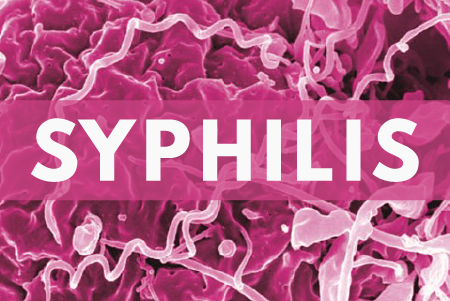
UPDATE OF AUGUST 12, 2019: The purpose of this Disease Debrief is to provide public health personnel in practice and in policy with a quick reference and to encourage practitioners to test for syphilis and other sexually transmitted infections (STIs) in individuals with opportunities for infection.
Risk factors for STIs are broad and outlined in Section 2: Canadian Guidelines on Sexually Transmitted Infections – Primary care and sexually transmitted infections.
Questions, comments and suggestions regarding this debrief are most welcome and can be sent to Sheikh.Qadar@umanitoba.ca.
What are Disease Debriefs? To find out more about how information is collected, see our page dedicated to the Disease Debriefs.
What are important characteristics of Syphilis?
CAUSE
Syphilis is a sexually-transmitted bacterial disease caused by bacterium Treponema pallidum subspecies pallidum. The strain T. pallidum subsp. pallidum causes venereal syphilis; T. pallidum subsp. endemicum causes endemic syphilis (bejel); T. pallidum subsp. pertenue causes yaws and T. carateum causes pinta.
Syphilis is the third most commonly reported STI in Canada, after Chlamydia and Gonorrhea. The infection can cause serious health consequences and moves through three stages if left untreated.
- Government of Canada: Canadian Guidelines on Sexually Transmitted Infections-Management and treatment of specific infections: Syphilis
- Government of Canada: Canada Communicable Disease Report, Syphilis
- CDC: Sexually Transmitted Diseases (STDs)-Syphilis-CDC Fact Sheet
SIGNS AND SYMPTOMS
Detailed descriptions of clinical manifestations in different stages of syphilis and the incubation time associated with each.
| Stage | Clinical signs & symptoms | Incubation period |
| Primary | Chancre (usually occurs where syphilis entered the body and at times difficult-to-notice area such as the vagina or anus), regional lymphadenopathy | 3-6 weeks |
| Secondary | Rash, fever, malaise, lymphadenopathy, mucus lesions, condyloma lata, patchy or diffuse alopecia, meningitis, headaches, uveitis, retinitis | 2-12 weeks(2 weeks–6 months) |
| Latent | Asymptomatic | Early: less than yearLate: at or after 1 year |
See Canadian Guidelines on STIs for signs and symptoms of Tertiary and Congenital Syphilis
- Government of Canada: Canadian Guidelines on Sexually Transmitted Infections, Management and treatment of specific infections, Syphilis: Manifestations
- CDC: Sexually Transmitted Diseases (STDs), Syphilis, CDC Fact Sheet
TRANSMISSION
The basic transmission mechanism is through vaginal, anal and/or oral sex. Syphilis may also be transmitted through needle sharing, blood transfusion, accidental inoculation, or organ transplantation.
In the case of transmission from women to infants, most of the congenital syphilis infections occur in utero, but syphilis can also be contracted with an active genital lesion at the time of delivery.
PREVENTION
In sexually active persons, the risk of syphilis should be clearly elucidated by health care professionals to avoid ambiguity, especially regarding transmission through oral sex and the use of protection. Patients should be provided information regarding safer sex and the use of barrier methods and needle-sharing practices to decrease the risk of transmission.
Testing and management prevents the spread of infection. All individuals with opportunities for infection should be tested along with the other STBBIs. To prevent congenital syphilis, routine prenatal screening for syphilis is recommended in the first trimester for all women. Repeat testing should be performed on patients living in high prevalence communities and populations and patients at risk during the third trimester (28-32 weeks) and at delivery. Infants born to mothers who have reactive nontreponemal and treponemal tests should be evaluated for congenital syphilis.
According to the CDC, partner-based interventions including partner notification (contact tracing) play a vital role in prevention of syphilis infections.
Patients with syphilis infections and their partners should abstain from unprotected intercourse until treatment of both partners is complete and an adequate serological response is determined.
For testing, treatment and management information:
Please see Section 5-10: Canadian Guidelines on Sexually Transmitted Infections- Management and treatment of specific infections – Syphilis or Provincial/Territorial/Jurisdictional guidelines or protocols.
Serological testing of syphilis requires interpretation of non-treponemal antibody screening tests and confirmatory treponemal antibody tests via algorithms. If syphilis is suspected and serological testing is negative, testing should be repeated in 2-4 weeks due to the time required for serological tests to detect infection. Individuals with past syphilis infection generally have reactive treponemal tests for life regardless of treatment, complicating diagnosis and management of repeat infections.
Treatment for syphilis is generally 2 deep intramuscular injections of Penicillin G, due to a large medication volume. Individuals with infection for more than one year or unknown duration require 3 treatments one week apart. Syphilis management includes 1-2 years of serological follow-up to monitor treatment success.
EPIDEMIOLOGY
Over recent years, rates of syphilis in Canada have surged. According to the Canada Communicable Diseases Report (2018) syphilis incidence increased by 85.6% from 2010 to 2015 (5.0 to 9.3 cases per 100,000 population). In females, the rate increased from 0.9 per 100,000 population in 2010 to 1.2 per 100,000 population in 2015 whereas in males the rate surged from 9.2 (2010) to 17.5 per 100,000 population (2015). These figures, however, do not reflect the most up-to-date information on syphilis incidence rates and outbreaks in Canadian provinces and territories.
What is happening with current outbreaks of Syphilis infections?
WHAT IS HAPPENING WITH CURRENT OUTBREAKS OF SYPHILIS INFECTIONS?
Many provinces in Canada have declared syphilis outbreaks in the last 5 years, including Ontario, Nunavut, Manitoba, Alberta, British Columbia and Saskatchewan. The following links provide the most current publicly available information:
- Alberta Health-Interactive Health Data Application-Sexually Transmitted Infections (STI)
- BCCDC-Reportable Diseases Dashboard-Syphilis Infections
- Population Health Indicators: 2018 At a Glance
- Saskatchewan Health Authority-Warning about increase in syphilis cases; encouraging preventative practices and testing
- Government of Manitoba-Syphilis factsheet
- Sexually Transmitted and Blood borne Infections (STBBI) in Manitoba
- Winnipeg Regional Health Authority-Syphilis Outbreak
- Public Health of Ontario- Monthly Infectious Diseases Surveillance Reports
